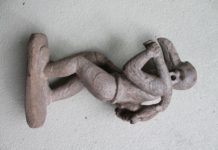Kazakh bone carvers (suyekshi) use traditional technique of bone processing and carving.
Samples of bone carving found in Central Kazakhstan are attributed to the culture of Neolithic Age, namely archaeologists discovered bone and horn needles (10 000 B.C.) and belt buckles with engraved patterns (300 B.C.). Among archaeological findings in Otrar city located along the Silk Road (1300-1400 A.D.) bone buttons, buckles and knife handles with engravings were found.
Usually geometrical plates (triangles, squares, circles) are cut from bones and inlayed into wood (front side of beds (tosekagash), yurt doors (assadal / kebezhe), front side of chests (sandyq), neck and head of string instruments. Scapula, jaw, ribs and lower leg of horses, camels, cows and ships are used for carving. For decoration of whip (qamshy) and dagger (qanzhar), handles horns of arhars, Central Asian gazelles and saiga are widely used. Bone hardness helps facilitate fine carving.
Processing of bones consist the following steps: decomposing the specimen, degreasing, whitening and sanitising. Bones are cut into plates, boiled until they get slightly soft, and then straightened with a vise (iskenzhe). The technique of bone carving includes flat carving, engraving, and hollow carving. The carving may have simple geometrical design, solar symbols or plant pattern.
Some items are whole carved. For example, shumek, a hygienic piece of the baby boy cradle, is made of sheep tubular bone. Tubular bones are boiled in milk for whitening and animal fat for moisture resistance. The bone itself is decorated with carving. For baby girl cradles shumek is made of wood.
The most common carved item is hair comb, usually made of bone with metal inlay or wood with bone inlay. The design usually includes village scenes, or compositions based on traditions and legends. Bone hairpins decorated with compositions with the image of birds are also popular. These items are also made as protective charms.
Modern artisans and bone carvers include T. Begimbet, the Beisbekovs, S. Rystan, Yi. Kazakov, S. Kokenov, A. Mustafayev, Ye. Abylov, N. Ospanov, S. Bashyrov and B. Atamkulov.





